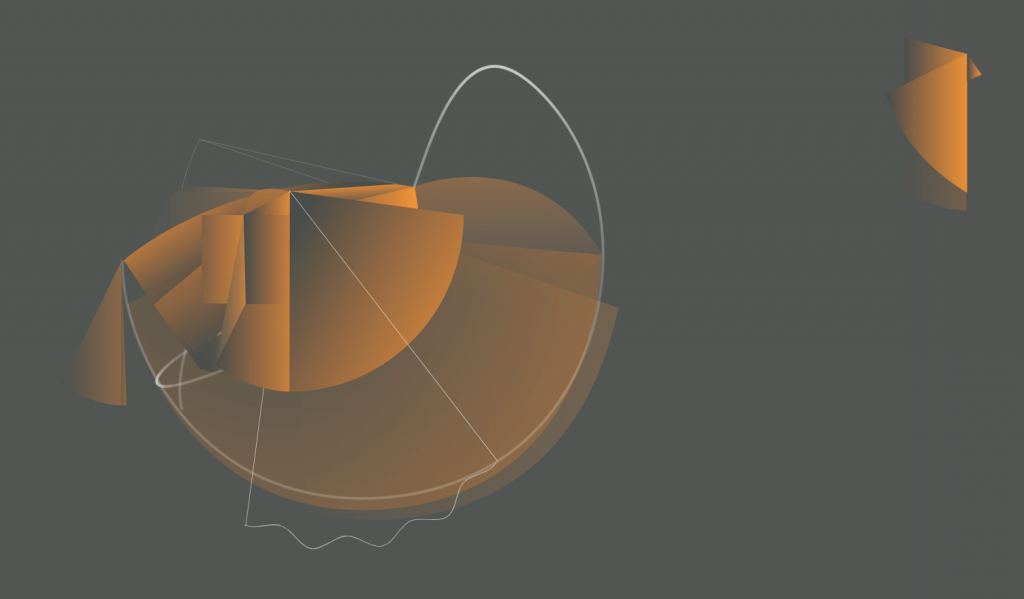 (For English please scroll down.)
(For English please scroll down.)
當拒絕歷史敘事與重建身份成為這個世代如此尋常的社會實踐時,我們不禁省視歷史竟被投以多少慾望、意義和情感。本展覽《肖像擺》試圖創造一個想像機械來探索當歷史之形象呈現時,與個體、集體、機制所交互扯動溢出的複雜協商關係。同時,展覽也呈現一則悖論來檢驗我們事實上如何渴望不在歷史進程中失所無處,並質問我們還能與歷史建構什麼不同的關係。何以身為獨立個體的我們嚮往去改造歷史,尤以其必然超越個人能及的文獻素材、敘事、記憶的總體,且又往往作為統治者所挪用的統御工具?這個計畫並不針對這些問題給予回覆、提出更為優化的歷史版本,或者去暗示壞歷史的樣貌,而是企圖更激進地探進一種歷史概念的新想像,我們如何在班雅明提出對於保羅・克利畫作《新天使》的解讀後,能夠看到不同的暴風、暴力、進步與天堂?(註一)又,我們要帶著這樣的新認知去往哪裡?
我們的動機從策展團隊著手進行的藝術史研究計畫其中隱含的問題意識出發,來自對如何在帝國之眼與後殖民論述之外找到新的辨識在地當代美學原初場景的方法感到好奇。為了創造一個對在地藝術史的另翼觀點,我們開始編寫自己的研究方法學,建立幾種能夠捕捉、召喚歷史形象呈現的線索:「生命檔案」用來收集生命史書寫、作品集、個人回憶等,「群像」的概念用以思考集體、社群、某思潮意識形態等形成的條件,「想像的機制」則作為描繪隱性驅力或是在既定社會脈絡裡對當權機制的反動力量。在此研究過程裡,我們發現當在不斷重新組編這些方法學及材料時,一個具生產性、本真性的空間即生成運轉於每次的構建中。於是啟發了我們將此對歷史思辨空間的思考,轉化為後續透過藝術語言表現、繼以展覽形式和內容的回應。
喻為展開混沌動態的雙擺,《肖像擺》自身即是一種概念裝置,捕捉描繪展中九個場景、十五位藝術家接續推演、往來於敘事和歷史間的動態。透過在展場建構高度流動對話性的場景提供另類空間場域,以揭露日常隱匿的關係和運動。在各種預設前提與當下情境的邊界消融失準之時,展覽物件間激化出更多的不穩定張力。《肖像擺》又像是提供多重曝光的特製暗房;浸潤在不穩定的化學藥劑裡,當下性不停歇地借光給歷史性。
回憶閃現。這是一個不停載動故事的機器。
這份不停歇或許正是理解關於時間的重量、現實條件情境、我們與過去的關係、甚至本展覽的關鍵。也因此,我們邀請你,不只一次地,來造訪這個貫穿九個場景的圖景和敘事世界,其中作品述說著、引扣著有關回憶或歷史材料的力量。它們或許魅惑你,以你兒時記憶中轉角小攤的熟悉味道、你父母年輕時哼唱的歌曲、你祖母花樣年華之際所寄以幻想的畫面、你與死黨一起看過的電影,然而展覽無意耽溺於任何懷舊或憂鬱情感,而這些作品揭示超越情感聯想的其他生產可能性。
事實上,《肖像擺》機器試圖拆解、分析和重構史觀,意圖在其運作方案裡與人類媒介與經驗認知拉出一個適切的距離,以關注將展示作品計畫同時作為美學事件(若我們可以接受稱呼概念物件為美學事件的話)以及歷史跡證的參照點。正如同歷史是無法被全面經驗的對象,這個展覽也無意操作為索引資料、文件或歷史再現的拼貼集合,且在一種現代藝術白盒子空間之對立面展開,拒絕成為一個(假)中性空間。在其隱喻性的運動中,它企圖顯明這些看似分立的美學事件如何持續地產生意義,並成為彼此的載具。亦可言,展覽架構作為一種提議方案,以放大展示物件間的對話:這是美學範疇的擴延,美學事件的內涵認知轉化空間,同時也作為一種文化交換介面,它們成為彼此的引力來納許具有生殖性意義的生產。它們不是只為觀看存在,其存在模式也不該被觀看消費。
展覽在此提示了歷史所帶給我們的真正挑戰非關我們如何再介入、詮釋、重寫,而在於我們如何理解其維度縱深、原則條件、模式與運動,在其混亂和我們幾近疲憊的勞動裡持續萃取知識與更深刻的觀點。或許憑此,我們將得以相信,儘管只是一種構圖的姿態也能把昨日與明日同時帶到現下,以虛構敘事的力量及想像之徑作為構建今日的方法。
註一 關於班雅明在〈歷史哲學史綱〉中論及此幅作品的原文段落譯文:「保羅‧克利的《新天使》畫中,一個天使看來正要從他入神地注目的事物旁離去。他凝視著前方,他的嘴微張,他的翅膀展開了。人們就是這樣描繪歷史天使的。他的臉朝著過去。在我們認為是一連串事件的地方,他看到的是一場單一的災難。這場災難堆積屍骸,將它們拋棄在他的面前。天使想停下來喚醒死者,把破碎的世界修補完整。可是從天堂吹來了一陣風暴,他猛烈地吹擊著天使的翅膀,以致他再也無法把它們收攏。這風暴無可抗拒地把天使刮向他背對著的未來,而他面前的殘垣斷壁卻越堆越高直逼天際。這場風暴就是我們所稱的進步。」Benjamin, Walter.”Theses on the Philosophy of History”, Illuminations, trans. Harry Zohn, New York: Schocken Books, 1969: 249.
As resisting accepted history and reinventing identity have become such a common social practice for our generation, we cannot help reflecting on how much desire, meaning and affection have been projected onto history, a subtext that runs through art production today. The exhibition Portrait Portrait creates an imaginary machine to explore the complex interactions between individuals, collectives and institutions in relation to the figuration of histories. Paradoxically, it both examines our desire for not being dispossessed in the process, and asks how we can act to construct different relations with it. Why do we, as individuals, aspire to transform history when what manifests as more than the totality of archival material, narration and memory that one could ever fully access is so often deployed as an institutional tool by the ruling class? This project does not illustrate direct answers to this question, nor does it seek to provide any better version of history, or suggest what bad history might be. Instead it asks if we can grow a radically new conception that follows Walter Benjamin’s reading on Klee’s Angelus Novus, and see the storm, the violence, the progress and the paradise differently.[1] And if we can, where will such new perceptions lead?
Our motivation began from a curiosity in re-identifying the primal scenes of the birth/burst of local contemporary aesthetics as a way to understand the writing of the art history outside of current empirical or post-colonial readings. To achieve this quest, we created our own methodologies to conduct our research, namely “bio archive”, “group portrait” and “imaginary institution”. Each was intended to capture some essences of history’s figuration. We employed “bio archive” to collect biographical and professional data, and record labor conditions, personal memories and so on. “Group portrait” inquired into the formation of collectives, communities or ideologies. “Imaginary institution” sought to depict invisible force or to replace the existing power construction in the social context. Working within these research frameworks, we discovered a generative space among the continuous reassembling of methods and materials. There lies an authenticity to each alternate composition or assemblage. It inspired us to perform this discursive space as an exhibition that reflects the subject and methodologies of our research in both its form and its content.
Portrait Portrait is a conceptual installation in nine progressive scenarios that present the work of fifteen artists in different configurations that unfold over time. Taking the chaotic motion of a double pendulum as its metaphor, it traces the interrelated movements of narrative and history.[2] Through building this dialectical system, in order to engineer alternative domains of conversation, the exhibition exposes invisible relations and movements. The boundaries between condition and situation are dissolved to generate uncertain dynamics among the exhibits. As an imaginary machine, Portrait Portrait is an apparatus that relentlessly reproduces images from the past to expose contemporaneity’s reliance on historicity in flashback. It is a machine that travels stories relentlessly.
It is this relentlessness, perhaps, that is the key to understand the weight of time, our present condition, our relations with the past and with this exhibition. Henceforth, you are invited to visit the imagery worlds of the nine scenarios more than once, where artworks speak and engage with the power invested in memory and historical materials. The works may lure you in with the smell of the street vendor next to your childhood home; a song your parents sang as teens; the image your grandma used to project her fantasies onto as she grew up with; or the movies you watched together with your childhood friend. However, this is intended to be neither nostalgic nor melancholic. The artistic appropriation of these everyday experiences suggests new possibilities for the production of history apart from such affective associations.
If fact, as a machine to parse and re-conceptualize history, Portrait Portrait intends to operate at a distance from human agency and experience in order to pay attention to both the exhibits as aesthetic events, and their reference points as historical evidence. Just as history cannot be fully grasped, Portrait Portrait functions neither as a collage of references, as documentation, nor as a representation of past events. Quite in opposition to the classical white cube, it refuses to be a neutral space, but embraces subjective readings. In its metaphorical movements, the exhibition illuminates how these seemingly separated aesthetic events can keep producing new meanings and act as carriers for one another. That is to say that its various articulations amplify the dialogue between its component parts. In this way it aims to expand the aesthetic domain to acknowledge art as conceptual objects, while simultaneously seeing them as a cultural currency where their interplay allows for further generative production. They do not stand only to be gazed upon, and their modes of being should not be simply consumed, but actively engaged with.
Through this Portrait Portrait suggests that the real challenge in facing history is not how we come to re-engage it, interpret it, or rewrite it, but how we comprehend its dimensions, principles, patterns, even its movements. Extracting knowledge and deeper perceptions from the chaos is an exhausting labor. But we would dare to believe that such a composition can be a gesture to bring both yesterday and tomorrow together, revealing the power of fiction and the path to imagination as a method for constituting the present.
[1] The original quote from Walter Benjamin on the painting: “A Klee painting named Angelus Novus shows an angel looking as though he is about to move away from something he is fixedly contemplating. His eyes are staring, his mouth is open, his wings are spread. This is how one pictures the angel of history. His face is turned toward the past. Where we perceive a chain of events, he sees one single catastrophe which keeps piling wreckage upon wreckage and hurls it in front of his feet. The angel would like to stay, awaken the dead, and make whole what has been smashed. But a storm is blowing from Paradise; it has got caught in his wings with such violence that the angel can no longer close them. The storm irresistibly propels him into the future to which his back is turned, while the pile of debris before him grows skyward. This storm is what we call progress.” Benjamin, Walter. “Theses on the Philosophy of History”, Illuminations, trans. Harry Zohn, New York: Schocken Books, 1969: p249.
[2] The Chinese title 肖像擺 directly translates as “Portrait of a Pendulum” implying an “image in motion”.
